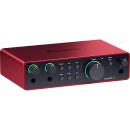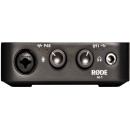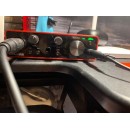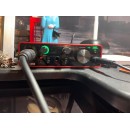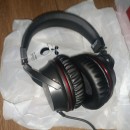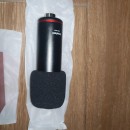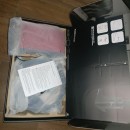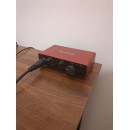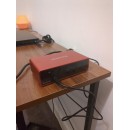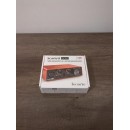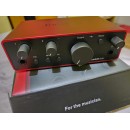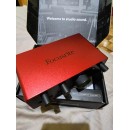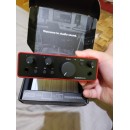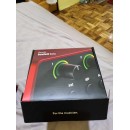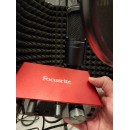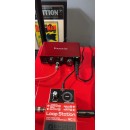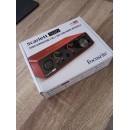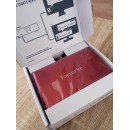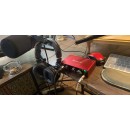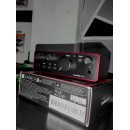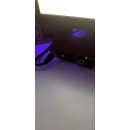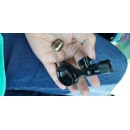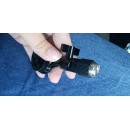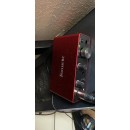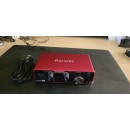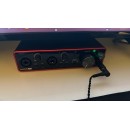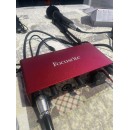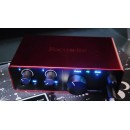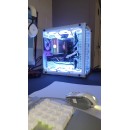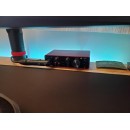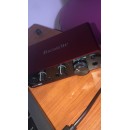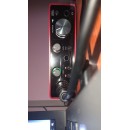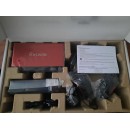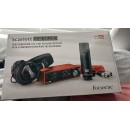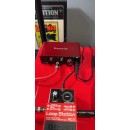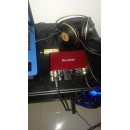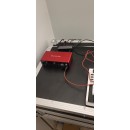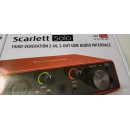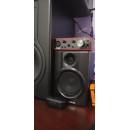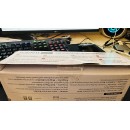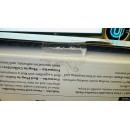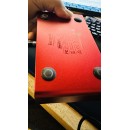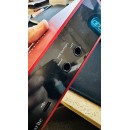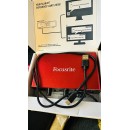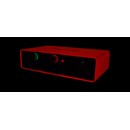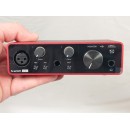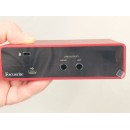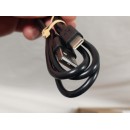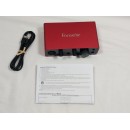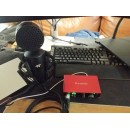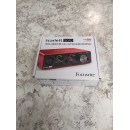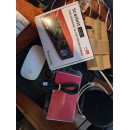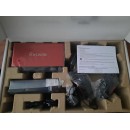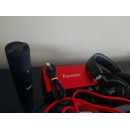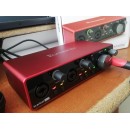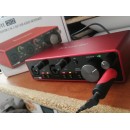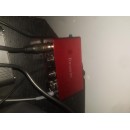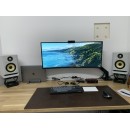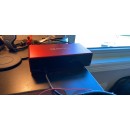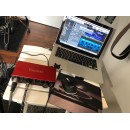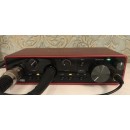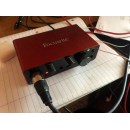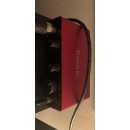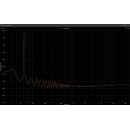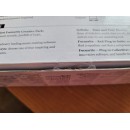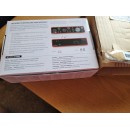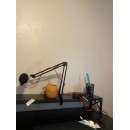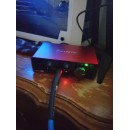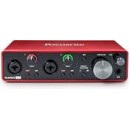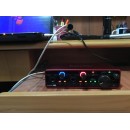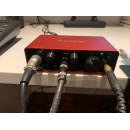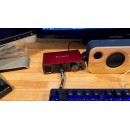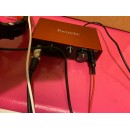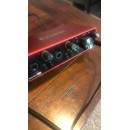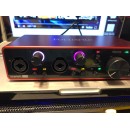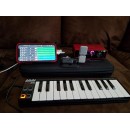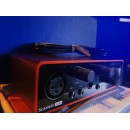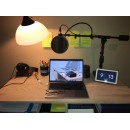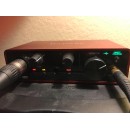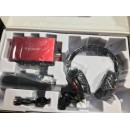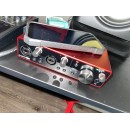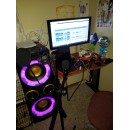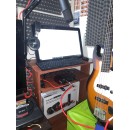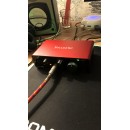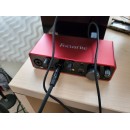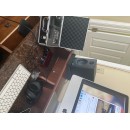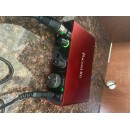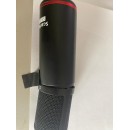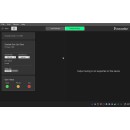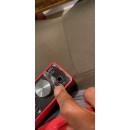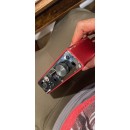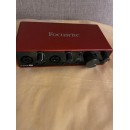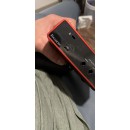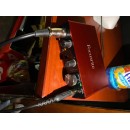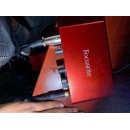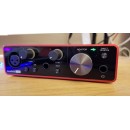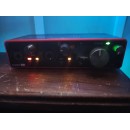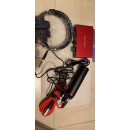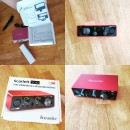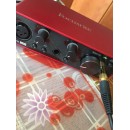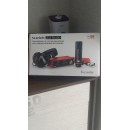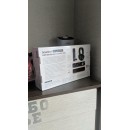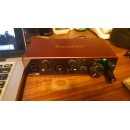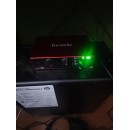RODE AI-1 vs Focusrite Scarlett 2i2 (4th Gen): Which Audio Interface is Right for You?
The Focusrite Scarlett 2i2 (4th Gen) is renowned for its high-quality preamps and excellent build quality. It features two combination inputs (XLR and ¼” TRS) that accommodate both microphones and instruments, making it highly versatile. The preamps offer a natural sound with low noise, and the interface includes Focusrite’s Air mode, which adds brightness and presence to recordings, emulating the classic ISA preamps. The 2i2 offers up to 24-bit/192kHz resolution, ensuring pristine audio quality. It also includes a comprehensive software bundle with Ableton Live Lite, Pro Tools First Focusrite Creative Pack, and various plug-ins and loops, providing a complete package for beginners and seasoned producers alike. Its user-friendly design and intuitive controls make it a go-to for musicians and podcasters seeking reliability and high performance.
On the other hand, the RODE AI-1 USB-C Audio Interface is designed with simplicity and durability in mind. It features a single Neutrik combo jack that supports both XLR and ¼” inputs, making it ideal for solo recording artists or podcasters. The AI-1 boasts a Class-A preamp that delivers clean and transparent sound, with zero-latency monitoring through its high-quality headphone output. The interface supports up to 24-bit/96kHz resolution, which is slightly lower than the Scarlett 2i2 but still offers excellent audio fidelity. The robust metal chassis ensures durability, and the straightforward design makes it exceptionally easy to use, especially for those who prefer a plug-and-play setup. The AI-1 is also bundled with Ableton Live Lite, providing essential tools to get started.
In summary, the Focusrite Scarlett 2i2 (4th Gen) is ideal for users who need multiple inputs and a comprehensive software package, along with the added benefit of the Air mode for enhanced sound quality. It is perfect for musicians and producers who require versatility and high performance. The RODE AI-1, with its simpler design and robust build, is perfect for solo artists or podcasters who prioritize ease of use and durability. Both interfaces offer excellent audio quality and reliability, making them strong contenders in the USB-C audio interface market.
In-Depth Comparison: Specifications, Advantages, and Disadvantages
| User Rating Based on Analysis of Reviews | |
|---|---|
|
Show More |
| Pros: | |
|---|---|
|
|
| Cons: | |
|---|---|
|
|
| Find Best Price | Find Best Price |
| Key Specs | |
|---|---|
| Channels of I/O | |
| Analog: 2 Inputs / 2 Outputs at 192 kHz |
1 Input / 2 Output |
| Maximum Sampling Rate | |
| 192 kHz / 24-Bit | 96 kHz / 24-Bit |
| Number of Microphone Inputs | |
| 2 | 1 |
| Analog Audio I/O | |
| 2x XLR 3-Pin Balanced Mic Input 2x 1/4" TRS Balanced/Unbalanced Line/Hi-Z Input (Front Panel) 2x 1/4" TRS Balanced Monitor Output 1x 1/4" TRS Headphone Output (Front Panel) |
1x Combo XLR-1/4" TRS Mic/Line Input 2x 1/4" TRS Balanced Line Output 1x 1/4" TRS Headphone Output |
| Digital Audio I/O | |
| Host Connection | |
| 1x USB-C | USB-C |
| OS Compatibility | |
| macOS Windows |
macOS 10.10 or Later Windows 7 or Later |
| Power Requirements | |
| USB Bus Power, USB Power Adapter (Not Included) | USB Bus Power |
The Focusrite Scarlett 2i2 offers more extensive input and output options with its 2-input/2-output configuration at 192 kHz. It includes 2 XLR 3-pin balanced mic inputs, 2 1/4" TRS balanced/unbalanced line/Hi-Z inputs on the front panel, and 2 1/4" TRS balanced monitor outputs. Additionally, it has a 1/4" TRS headphone output on the front panel. This setup is ideal for users needing multiple input options for microphones and instruments. The Scarlett 2i2’s maximum sampling rate is 192 kHz at 24-bit, which provides high-quality audio resolution. It is compatible with both macOS and Windows operating systems and can be powered via USB bus power or an optional USB power adapter.
On the other hand, the RODE AI-1 USB-C Audio Interface is simpler in terms of input/output channels, with a 1-input/2-output configuration at 96 kHz. It features a single combo XLR-1/4" TRS mic/line input, 2 1/4" TRS balanced line outputs, and a 1/4" TRS headphone output. The maximum sampling rate of the AI-1 is 96 kHz at 24-bit, which is sufficient for high-quality audio recording but not as high as the Scarlett 2i2. The RODE AI-1 is also compatible with both macOS (version 10.10 or later) and Windows (version 7 or later) operating systems, and it operates solely on USB bus power.
In summary, the Focusrite Scarlett 2i2 USB-C Audio Interface (4th Generation) provides a more versatile and higher-resolution recording setup with additional input options and a higher maximum sampling rate. It is suitable for users who need more flexibility and higher audio quality. The RODE AI-1 USB-C Audio Interface, while more basic in comparison, still offers solid performance with its simpler configuration, making it a good choice for users who need a straightforward and reliable audio interface for basic recording tasks.
| General | |
|---|---|
| Channels of I/O | |
| Analog: 2 Inputs / 2 Outputs at 192 kHz |
1 Input / 2 Output |
| Built-In DSP | |
| Maximum Sampling Rate | |
| 192 kHz / 24-Bit | 96 kHz / 24-Bit |
| Number of Microphone Inputs | |
| 2 | 1 |
| Built-In Microphone | |
| Input Level Adjustment | |
| 2x Knob | 2x Knob |
| Expansion Slots | |
The Focusrite Scarlett 2i2 offers 2 analog inputs and 2 analog outputs at a maximum sampling rate of 192 kHz and 24-bit resolution. This makes it capable of handling high-fidelity audio recording and playback. It includes 2 microphone inputs, which are ideal for users who need to record using multiple mics simultaneously. The device does not have built-in DSP or a built-in microphone, but it provides input level adjustment through 2 dedicated knobs. There are no expansion slots available on this audio interface, making it a straightforward, plug-and-play solution.
On the other hand, the RODE AI-1 USB-C Audio Interface features 1 input and 2 outputs, with a maximum sampling rate of 96 kHz and 24-bit resolution. This unit is designed with 1 microphone input, catering to solo recording needs. Similar to the Focusrite Scarlett 2i2, the RODE AI-1 lacks built-in DSP and a built-in microphone. It also offers input level adjustment through 2 knobs and does not include expansion slots.
In summary, the Focusrite Scarlett 2i2 stands out with its higher number of input channels and a higher maximum sampling rate, making it more versatile for multi-microphone setups and high-resolution audio tasks. The RODE AI-1, while more limited in input capacity and sampling rate, remains a solid choice for simpler recording needs, particularly for solo artists or podcasters. Both devices share common features like input level adjustment through knobs and the absence of built-in DSP and expansion slots.
| Signal Processing | |
|---|---|
| Gain/Trim Range | |
| Mic/Line Inputs: Up to +69 dB Hi-Z Inputs: 62 dB |
Inputs: 0 to 45 dB |
In contrast, the RODE AI-1 USB-C Audio Interface has a gain/trim range for its inputs running from 0 to 45 dB. While this range is sufficient for many applications, it does not offer the same level of flexibility as the Scarlett 2i2. This could be a limiting factor for users who require higher gain levels for certain microphones or instruments.
Another notable difference is the inclusion of additional features in the Scarlett 2i2. For instance, the RODE AI-1 lacks a high-pass filter and solo/mute functionality, which can be useful for managing and refining the audio input during recording sessions. The absence of these features in the AI-1 may make it less suitable for users who need more nuanced control over their audio inputs.
In summary, the Focusrite Scarlett 2i2 USB-C Audio Interface (4th Generation) offers a more extensive gain/trim range and additional features that provide greater control and flexibility, making it a more versatile choice for a wide range of recording needs. The RODE AI-1 USB-C Audio Interface, while competent, offers a more limited gain/trim range and lacks some of the additional features found in the Scarlett 2i2, which may make it less ideal for users with more demanding audio requirements.
| Connectivity | |
|---|---|
| Analog Audio I/O | |
| 2x XLR 3-Pin Balanced Mic Input 2x 1/4" TRS Balanced/Unbalanced Line/Hi-Z Input (Front Panel) 2x 1/4" TRS Balanced Monitor Output 1x 1/4" TRS Headphone Output (Front Panel) |
1x Combo XLR-1/4" TRS Mic/Line Input 2x 1/4" TRS Balanced Line Output 1x 1/4" TRS Headphone Output |
| Phantom Power | |
| 48 V, Selectable On/Off | 48 V |
| Digital Audio I/O | |
| Host Connection | |
| 1x USB-C | USB-C |
| Host Connection Protocol | |
| USB 2.0 | Not Specified by Manufacturer |
| USB (Non-Host) | |
| 1x USB-C (Power Input) | |
| Sync I/O | |
| Network I/O | |
| MIDI I/O | |
The Focusrite Scarlett 2i2 (4th Generation) offers more extensive analog audio I/O options compared to the RODE AI-1. It features 2x XLR 3-Pin balanced mic inputs and 2x 1/4" TRS balanced/unbalanced line/Hi-Z inputs on the front panel, making it versatile for both microphone and instrument inputs. Additionally, it has 2x 1/4" TRS balanced monitor outputs and 1x 1/4" TRS headphone output on the front panel, which provides flexible monitoring options. The Scarlett 2i2 also includes selectable 48V phantom power, which is essential for powering condenser microphones. The interface connects to the host via 1x USB-C using the USB 2.0 protocol and also has an additional USB-C port for power input. However, it lacks digital audio I/O, MIDI I/O, network I/O, and wireless features.
In contrast, the RODE AI-1 USB-C Audio Interface is more simplified but still effective for basic recording needs. It has 1x combo XLR-1/4" TRS mic/line input, which supports both microphone and line-level signals, and 2x 1/4" TRS balanced line outputs for connecting to studio monitors. Like the Scarlett 2i2, it also includes 1x 1/4" TRS headphone output for monitoring and provides 48V phantom power for condenser microphones. The host connection is via USB-C, but the specific protocol is not specified by the manufacturer. The RODE AI-1 does not include additional USB ports, digital audio I/O, MIDI I/O, network I/O, or wireless capabilities.
In summary, the Focusrite Scarlett 2i2 (4th Generation) offers greater flexibility with more input options and an additional USB-C port for power, making it suitable for users who need to connect multiple devices simultaneously. The RODE AI-1, on the other hand, provides a more straightforward setup with essential features that cater to users looking for a simpler, more streamlined interface.
| Performance | |
|---|---|
| Frequency Response | |
| XLR Mic Inputs: 20 Hz to 20 kHz ±0.06 dB 1/4" Line Inputs: 20 Hz to 20 kHz 0.05 dB 1/4" Hi-Z Inputs: 20 Hz to 20 kHz 0.15 dB |
20 Hz to 20 kHz ±1 dB |
| Maximum Output Level | |
| 1/4" Line: +16 dBu |
Monitor Outputs: -6 dBu |
| Headphone Output Power | |
| 1/4": 32 mW into 33 Ohms 22 mW into 300 Ohms |
24 mW into 32 Ohms 245 mW into 300 Ohms |
| Impedance | |
| XLR Mic Inputs: 3 Kilohms 1/4" Line Inputs: 60 Kilohms 1/4" Hi-Z Inputs: 1 Megohms 1/4" Line Outputs: 100 Ohms 1/4" Headphone Outputs: < 50 Ohm |
Hi-Z Inputs: 0.9 Megohm Mic Inputs: 1.3 Kilohms |
| Dynamic Range | |
| XLR Mic Inputs: 116 dBA 1/4" Line Inputs: 115.2 dBA 1/4" Hi-Z Inputs: 113 dBA 1/4" Line Outputs: 120 dB 1/4" Headphone: 112 dB (at 33 Ohms) 115 dB (at 300 Ohms) Digital A/D Converters: 120 dB Digital D/A Converters: 130 dBA |
104 dBu |
| EIN | |
| XLR Mic Inputs: -127 dBu A-Weighted |
-128 dBA |
Starting with frequency response, the Scarlett 2i2 offers impressive precision across its inputs, with XLR mic inputs delivering a frequency response of 20 Hz to 20 kHz ±0.06 dB, 1/4" line inputs at 20 Hz to 20 kHz 0.05 dB, and 1/4" Hi-Z inputs at 20 Hz to 20 kHz 0.15 dB. In comparison, the RODE AI-1 provides a more general frequency response of 20 Hz to 20 kHz ±1 dB, which is adequate but not as finely calibrated as the Scarlett 2i2.
In terms of maximum input levels, the Scarlett 2i2 also outperforms with XLR mic inputs handling up to 16 dBu, 1/4" line inputs up to 22 dBu, and 1/4" Hi-Z inputs up to 12 dBu. The RODE AI-1 does not specify maximum input levels, focusing instead on maximum output level for monitor outputs at -6 dBu, which is lower than the Scarlett's maximum output level of +16 dBu for 1/4" line outputs.
For headphone output power, the Scarlett 2i2 delivers 32 mW into 33 Ohms and 22 mW into 300 Ohms. The RODE AI-1, however, provides significantly higher power at 24 mW into 32 Ohms and 245 mW into 300 Ohms, making it potentially more suitable for high-impedance headphones.
When it comes to impedance, the Scarlett 2i2 displays diversified values: XLR mic inputs at 3 Kilohms, 1/4" line inputs at 60 Kilohms, 1/4" Hi-Z inputs at 1 Megohm, and 1/4" line outputs at 100 Ohms, with headphone outputs at <50 Ohms. The RODE AI-1 features Hi-Z inputs at 0.9 Megohms and mic inputs at 1.3 Kilohms, which are generally lower than the Scarlett's corresponding inputs.
The dynamic range is another area where the Scarlett 2i2 excels, offering 116 dBA for XLR mic inputs, 115.2 dBA for 1/4" line inputs, 113 dBA for 1/4" Hi-Z inputs, and 120 dB for 1/4" line outputs. Its headphone dynamic range is 112 dB at 33 Ohms and 115 dB at 300 Ohms, with digital A/D converters at 120 dB and D/A converters at 130 dBA. The RODE AI-1's dynamic range is more modest at 104 dBu.
In terms of Total Harmonic Distortion plus Noise (THD+N), the Scarlett 2i2 is quite low, with XLR mic inputs and 1/4" line inputs both at -100 dB at 8 dB gain, and 1/4" Hi-Z inputs at -80 dB at minimum gain. Its 1/4" line outputs are at -109 dB, and headphone outputs vary between -99 dB at 33 Ohms and -108 dB at 300 Ohms. The Scarlett's digital A/D converters feature -110 dB while the D/A converters are at -115 dB. The RODE AI-1, however, does not specify THD+N values.
Lastly, Equivalent Input Noise (EIN) sees the Scarlett 2i2 at a competitive -127 dBu A-Weighted, while the RODE AI-1 slightly edges it out at -128 dBA.
In summary, the Focusrite Scarlett 2i2 USB-C Audio Interface (4th Generation) offers more detailed and precise specifications, with higher maximum input/output levels, a broader dynamic range, and lower THD+N values, making it a robust choice for professional audio recording and production. The RODE AI-1, while still a capable interface, may appeal more to users needing higher headphone output power and simpler specifications.
| Digital Audio | |
|---|---|
| Sample Rates | |
| 44.1 / 48 / 88.2 / 96 / 176.4 / 192 kHz | 44.1 / 48 / 88.2 / 96 kHz |
| Bit Depths | |
| 24-Bit | 24-Bit |
The Focusrite Scarlett 2i2 offers a wider range of sample rates, supporting 44.1, 48, 88.2, 96, 176.4, and 192 kHz. This extensive range allows for greater flexibility in recording and producing high-resolution audio. It operates at a 24-bit depth, ensuring a high level of detail and dynamic range in audio capture. The Scarlett 2i2 uses an internal sync source for clocking, which helps maintain audio fidelity and timing accuracy.
On the other hand, the RODE AI-1 supports sample rates of 44.1, 48, 88.2, and 96 kHz, which, although slightly limited compared to the Scarlett 2i2, still covers the most commonly used rates in professional and home studios. It also records at a 24-bit depth, providing comparable audio quality to the Scarlett 2i2. Additionally, the AI-1 features zero-latency direct monitoring, which is crucial for real-time audio monitoring without delay, enhancing the recording experience. Like the Scarlett 2i2, it uses an internal clocking source.
In summary, the Focusrite Scarlett 2i2 offers a broader range of sample rates, which might be beneficial for more detailed audio work, while the RODE AI-1 provides zero-latency direct monitoring, which can be a significant advantage for live recording sessions. Both interfaces offer high-quality 24-bit audio resolution and use internal clocking to ensure audio precision.
| Compatibility | |
|---|---|
| OS Compatibility | |
| macOS Windows |
macOS 10.10 or Later Windows 7 or Later |
The Focusrite Scarlett 2i2 (4th Generation) is compatible with both macOS and Windows operating systems. It also offers mobile app compatibility, specifically with iPadOS, allowing for greater flexibility and portability in various recording environments. This feature is particularly advantageous for users who want to integrate their iPad into their recording setup for on-the-go production and mixing.
On the other hand, the RODE AI-1 USB-C Audio Interface supports macOS 10.10 or later and Windows 7 or later. While it covers a broad range of operating systems, it does not offer compatibility with mobile apps or iPadOS. This limits its use to more traditional desktop and laptop setups, which may be a consideration for those looking to incorporate mobile devices into their workflow.
In summary, the Focusrite Scarlett 2i2 (4th Generation) provides broader OS compatibility and the added benefit of iPadOS support, making it a versatile choice for users who appreciate mobile integration. The RODE AI-1, while offering strong compatibility with both macOS and Windows, lacks mobile app support, which may be a limitation for some users.
| Power | |
|---|---|
| Power Requirements | |
| USB Bus Power, USB Power Adapter (Not Included) | USB Bus Power |
The Focusrite Scarlett 2i2 can be powered via USB Bus Power or an optional USB Power Adapter, providing flexibility for different recording scenarios. It also supports an AC/DC Power Adapter with a specification of 5 VDC at 900 mA, ensuring stable operation in more demanding environments. The power consumption of the Scarlett 2i2 is relatively low at 4.5 W, making it efficient in terms of energy use.
In contrast, the RODE AI-1 is solely reliant on USB Bus Power for its operation. This simplifies its connectivity and setup, especially for users who prefer fewer cables and accessories. The absence of an option for an external power adapter could be seen as a limitation for those who require more versatile power options or additional stability in power supply.
In summary, while both audio interfaces can be powered through USB Bus Power, the Focusrite Scarlett 2i2 offers additional flexibility with the option for an external USB Power Adapter and an AC/DC Power Adapter. This makes it potentially more versatile and reliable in a wider range of recording environments compared to the RODE AI-1, which exclusively relies on USB Bus Power.
| Physical | |
|---|---|
| Dimensions | |
| 7.1 x 4.6 x 1.87" / 18 x 11.7 x 4.75 cm | 4.9 x 3.9 x 1.5" / 124 x 100 x 38 mm |
| Weight | |
| 1.3 lb / 595.0 g | 19.8 oz / 561.3 g |
The Focusrite Scarlett 2i2 (4th Generation) measures 7.1 x 4.6 x 1.87 inches (18 x 11.7 x 4.75 cm) and weighs 1.3 lbs (595 grams). This makes it relatively compact and lightweight, suitable for both stationary use in a home studio and mobile recording setups.
On the other hand, the RODE AI-1 USB-C Audio Interface is more compact with dimensions of 4.9 x 3.9 x 1.5 inches (124 x 100 x 38 mm) and weighs 19.8 oz (561.3 grams). Despite being slightly lighter than the Scarlett 2i2, the AI-1's smaller form factor makes it an even more portable option, ideal for musicians and podcasters who need a highly portable interface solution without sacrificing performance.
In summary, both audio interfaces offer portable and lightweight designs, but the RODE AI-1 is slightly more compact and lighter compared to the Focusrite Scarlett 2i2 (4th Generation), which could be a deciding factor for users prioritizing portability.
| Packaging Info | |
|---|---|
| Package Weight | |
| 1.9 lb | 1.155 lb |
| Box Dimensions (LxWxH) | |
| 8.2 x 7 x 2.6" | 7 x 5.1 x 2.55" |
The Focusrite Scarlett 2i2 (4th Generation) has a package weight of 1.9 pounds, making it relatively heavier compared to the RODE AI-1, which weighs 1.155 pounds. This suggests that the Scarlett 2i2 might have a more robust build or include additional materials in the packaging.
In terms of box dimensions, the Focusrite Scarlett 2i2 measures 8.2 x 7 x 2.6 inches, whereas the RODE AI-1 has slightly more compact dimensions at 7 x 5.1 x 2.55 inches. The difference in size indicates that the Scarlett 2i2's packaging is larger, possibly accommodating more components or providing additional protection during transit.
Overall, while both audio interfaces are geared towards high-quality audio capture and USB-C connectivity, the Focusrite Scarlett 2i2 (4th Generation) is heavier and comes in a larger box compared to the more compact and lighter RODE AI-1.
| Customer Images | |
|---|---|
| Videos | |
|---|---|
|
|
|
